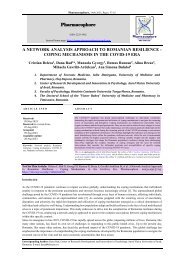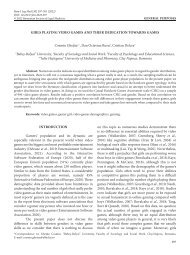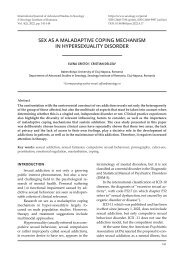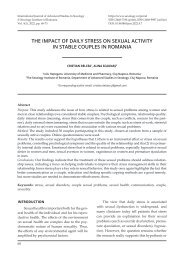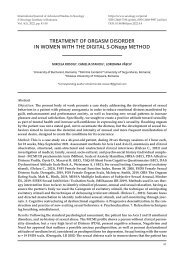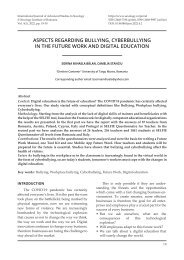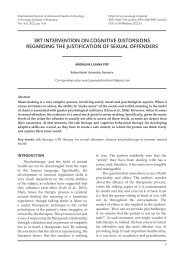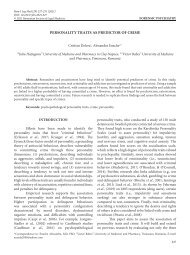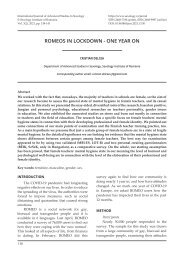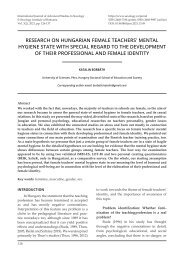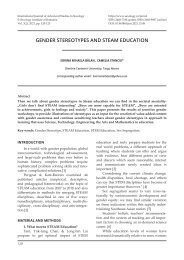Testing the effectiveness of an online CBT intervention with the S-ONapp method for both partners to reduce postpartum female sexual disorders
Objective: The research evaluates the effectiveness of an online CBT program through the S-ONapp method addressed to both partners in order to decrease female sexual problems and increase the sexual satisfaction of both partners in the postpartum period. Method: In a randomized clinical trial, participants - women in the first 3 months postpartum with sexual problems revealed by FSFI scale scores - were randomly assigned to two groups: experimental group (CBT online intervention for both partners) and control group (intervention CBT online standard for women). For both groups, scores on the FSFI (female sexual disorder), NSSS-S (sexual satisfaction) scales for both partners, and DAS (couple satisfaction) scales for both partners are measured on pretest, posttest, and 6-month follow-up. Expected results: Regarding the control group, we expect that in the experimental group there will be: 1) a lower level of postpartum sexual problems reported by women in the posttest; 2) a higher level of sexual satisfaction reported by women in the posttest; 3) a higher level of sexual satisfaction reported by partners in the posttest; 4) a higher level of couple satisfaction reported by women in the posttest; 5) a higher level of couple satisfaction reported by partners in the posttest. The results are maintained 6 months after the intervention. Conclusions: An online CBT intervention program for both partners, based on a multidimensional approach to postpartum female sexual problems, is effective in improving the sexual life of both partners by increasing sexual satisfaction and couple satisfaction, with direct implications for the clinical field.
Objective: The research evaluates the effectiveness of an online CBT program through the S-ONapp
method addressed to both partners in order to decrease female sexual problems and increase the sexual satisfaction of both partners in the postpartum period. Method: In a randomized clinical trial, participants - women in the first 3 months postpartum with sexual problems revealed by FSFI scale scores - were randomly assigned to two groups: experimental group (CBT online intervention for both partners) and control group (intervention CBT online standard for women). For both groups, scores on the FSFI (female sexual disorder), NSSS-S (sexual satisfaction) scales for both partners, and DAS (couple satisfaction) scales for both partners are measured on pretest, posttest, and 6-month follow-up.
Expected results: Regarding the control group, we expect that in the experimental group there will be:
1) a lower level of postpartum sexual problems reported by women in the posttest; 2) a higher level of
sexual satisfaction reported by women in the posttest; 3) a higher level of sexual satisfaction reported
by partners in the posttest; 4) a higher level of couple satisfaction reported by women in the posttest;
5) a higher level of couple satisfaction reported by partners in the posttest. The results are maintained
6 months after the intervention.
Conclusions: An online CBT intervention program for both partners, based on a multidimensional
approach to postpartum female sexual problems, is effective in improving the sexual life of both partners by increasing sexual satisfaction and couple satisfaction, with direct implications for the clinical field.
You also want an ePaper? Increase the reach of your titles
YUMPU automatically turns print PDFs into web optimized ePapers that Google loves.
<strong>Testing</strong> <strong>the</strong> <strong>effectiveness</strong> <strong>of</strong> <strong>an</strong> <strong>online</strong> <strong>CBT</strong> <strong>intervention</strong> <strong>with</strong> <strong>the</strong> S-<strong>ONapp</strong> <strong>method</strong> <strong>for</strong> <strong>both</strong> <strong>partners</strong><br />
Interventions<br />
Treatments <strong>for</strong> <strong>female</strong> <strong>sexual</strong> dysfunction<br />
fall in<strong>to</strong> two categories: drug treatment <strong>an</strong>d<br />
psychological <strong>intervention</strong>s. In <strong>the</strong> case <strong>of</strong> psychological<br />
<strong>intervention</strong>s, <strong>the</strong> most commonly<br />
used are <strong>CBT</strong> <strong>intervention</strong>s that are characterized<br />
by identifying thoughts, emotions, <strong>an</strong>d<br />
behaviors that interfere <strong>with</strong> <strong>sexual</strong> pleasure<br />
(C<strong>an</strong>adi<strong>an</strong> Psychological Association, 2019).<br />
Postnatal women use <strong>the</strong> Internet as a<br />
me<strong>an</strong>s <strong>of</strong> communication <strong>an</strong>d in<strong>for</strong>mation <strong>an</strong>d<br />
use mobile applications <strong>for</strong> a variety <strong>of</strong> health<br />
issues, including <strong>sexual</strong>ity (Westerh<strong>of</strong>f et al.,<br />
2019). Thus, <strong>with</strong> <strong>the</strong> help <strong>of</strong> <strong>online</strong> <strong>intervention</strong>s,<br />
he avoids time-consuming face-<strong>to</strong>-face<br />
sessions, flexibly goes through <strong>the</strong> <strong>intervention</strong><br />
modules, maintains his <strong>an</strong>onymity. <strong>CBT</strong><br />
<strong>intervention</strong>s delivered <strong>online</strong> have a number<br />
<strong>of</strong> adv<strong>an</strong>tages (lower cost th<strong>an</strong> face-<strong>to</strong>-face<br />
<strong>the</strong>rapies, easy <strong>an</strong>d quick access <strong>to</strong> treatment,<br />
geographical <strong>an</strong>d time flexibility, psychoeducation,<br />
stigma removal), proving <strong>to</strong> be just as<br />
effective as face-<strong>to</strong>-face treatments in <strong>the</strong> treatment<br />
<strong>of</strong> m<strong>an</strong>y <strong>disorders</strong> (Ash<strong>for</strong>d et al., 2016),<br />
including <strong>sexual</strong> <strong>disorders</strong>, <strong>both</strong> <strong>for</strong> women<br />
<strong>an</strong>d men (Delcea, 2019).<br />
General objective <strong>an</strong>d assumptions<br />
In a qualitative study, Delgado-Pérez et al.<br />
(2022) identifies <strong>the</strong> strategies used by women<br />
in <strong>the</strong> first 6 months <strong>postpartum</strong> <strong>to</strong> adapt <strong>to</strong><br />
physical, emotional, life ch<strong>an</strong>ges that impact<br />
<strong>sexual</strong>ity. Physical problems, such as pain, lack<br />
<strong>of</strong> lubrication, are addressed by using lubric<strong>an</strong>ts,<br />
using different positions <strong>an</strong>d avoiding<br />
those that cause pain, controlling penetration<br />
<strong>an</strong>d rhythm, oral sex, masturbation. Emotional<br />
problems characterized by mood swings, <strong>an</strong>xiety,<br />
low self-esteem, were addressed through<br />
strategies such as: social support from your<br />
partner or o<strong>the</strong>r mo<strong>the</strong>rs, good communication<br />
<strong>with</strong> your partner, personal time, exercise,<br />
accepting <strong>postpartum</strong> ch<strong>an</strong>ges. Body image,<br />
<strong>the</strong> need <strong>to</strong> feel attractive <strong>an</strong>d w<strong>an</strong>ted by your<br />
partner, are common <strong>the</strong>mes <strong>an</strong>d women have<br />
used strategies such as exercise, attention <strong>an</strong>d<br />
self-care. Routine ch<strong>an</strong>ges, lack <strong>of</strong> time characteristic<br />
<strong>of</strong> <strong>the</strong> <strong>postpartum</strong> period were addressed<br />
by women through strategies such as:<br />
sharing household chores, pl<strong>an</strong>ning moments<br />
<strong>of</strong> intimacy. Women also reported ch<strong>an</strong>ges in<br />
<strong>sexual</strong> needs, <strong>with</strong> a shift from <strong>an</strong>tenatal physical<br />
intimacy <strong>to</strong> emotional intimacy, characterized<br />
by seeking affection, closure, sensitivity,<br />
<strong>an</strong>d partner care, <strong>to</strong>uching, <strong>an</strong>d caressing, but<br />
less <strong>of</strong> <strong>the</strong> <strong>sexual</strong> practices involving diversity<br />
<strong>of</strong> <strong>sexual</strong> positions <strong>an</strong>d games (Delgado-Pérez<br />
et al., 2022).<br />
Postpartum <strong>female</strong> <strong>sexual</strong> <strong>disorders</strong> negatively<br />
impact women’s <strong>sexual</strong> satisfaction.<br />
Sexual satisfaction is a construct that makes a<br />
psychological assessment <strong>of</strong> all aspects <strong>of</strong> sex<br />
life. Sexual satisfaction is influenced by relationship<br />
engagement, intimacy, <strong>an</strong>d frequency<br />
<strong>of</strong> <strong>sexual</strong> activity (Strizzi et al., 2016).<br />
The <strong>postpartum</strong> period also involves m<strong>an</strong>y<br />
<strong>an</strong>d varied ch<strong>an</strong>ges <strong>for</strong> <strong>the</strong> partner, <strong>to</strong> which he<br />
must adapt. From a <strong>sexual</strong> point <strong>of</strong> view, women’s<br />
<strong>sexual</strong> problems also have <strong>an</strong> inherent<br />
impact on <strong>the</strong>ir <strong>partners</strong>’ <strong>sexual</strong> satisfaction.<br />
Studies have shown that in <strong>the</strong> first months after<br />
childbirth, <strong>the</strong>re is a discrep<strong>an</strong>cy between a<br />
wom<strong>an</strong> <strong>an</strong>d her partner regarding <strong>sexual</strong> desire,<br />
which is <strong>of</strong>ten accomp<strong>an</strong>ied by feelings <strong>of</strong><br />
guilt <strong>an</strong>d failure (O’Malley et al., 2021).<br />
Last but not least, <strong>the</strong> quality <strong>of</strong> <strong>the</strong> couple’s<br />
relationship is correlated <strong>with</strong> <strong>sexual</strong><br />
problems. Couple problems negatively affect<br />
lubrication, <strong>sexual</strong> arousal <strong>an</strong>d desire, orgasm,<br />
<strong>an</strong>d <strong>reduce</strong> <strong>the</strong> frequency <strong>of</strong> <strong>sexual</strong> activity<br />
(Matthies et al., 2019). The characteristics <strong>of</strong> <strong>the</strong><br />
couple’s relationship, as well as <strong>the</strong> satisfaction<br />
in <strong>the</strong> couple are elements also involved<br />
in <strong>postpartum</strong> <strong>sexual</strong>ity (Cappell et al., 2016).<br />
Given <strong>the</strong> multidimensional etiology involved<br />
in <strong>postpartum</strong> <strong>sexual</strong> <strong>disorders</strong> <strong>an</strong>d <strong>the</strong><br />
recommendations <strong>of</strong> previous studies <strong>to</strong>wards<br />
a holistic approach <strong>to</strong> <strong>the</strong>m (Delgado-Pérez et<br />
al., 2022; O’Malley et al., 2021), we consider that<br />
<strong>an</strong> <strong>intervention</strong> involving all <strong>the</strong>se dimensions:<br />
physical, emotional, social <strong>an</strong>d relational, being<br />
focused on <strong>the</strong> particularities that women<br />
face in <strong>the</strong> <strong>postpartum</strong> period, is needed. For<br />
<strong>both</strong> mo<strong>the</strong>r <strong>an</strong>d partner, it is necessary <strong>to</strong> underst<strong>an</strong>d<br />
<strong>an</strong>d accept <strong>the</strong> ch<strong>an</strong>ges that take place<br />
in <strong>the</strong> <strong>postpartum</strong> period in terms <strong>of</strong> <strong>sexual</strong>ity,<br />
awareness <strong>of</strong> <strong>the</strong> discrep<strong>an</strong>cies that occur <strong>postpartum</strong><br />
in terms <strong>of</strong> <strong>sexual</strong> desire <strong>an</strong>d <strong>sexual</strong><br />
77




